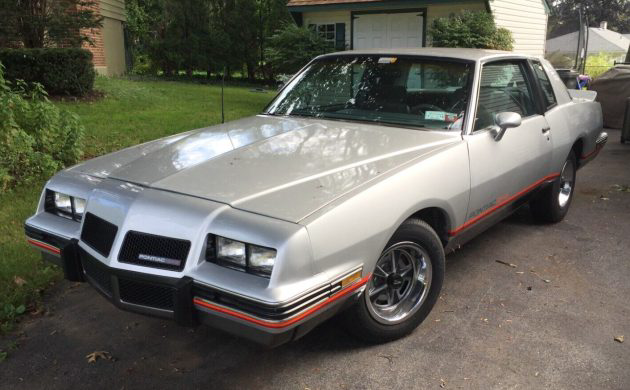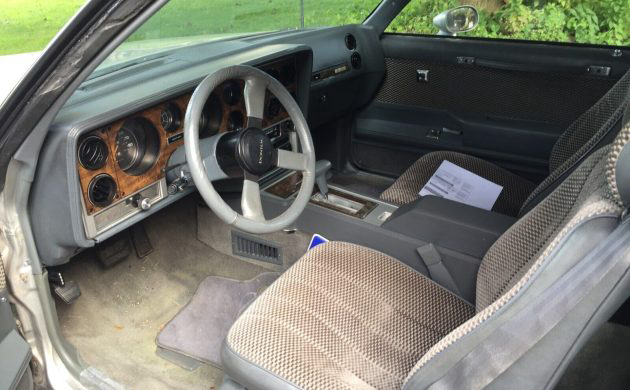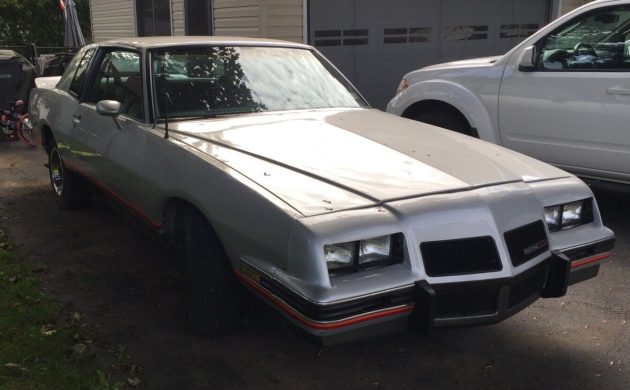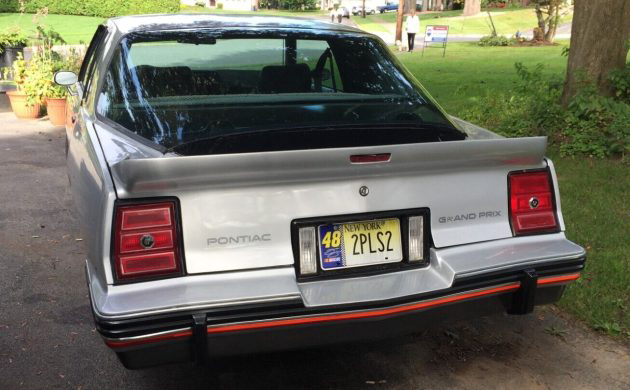It is often said that racing improves the breed, and the move by Formula One to a hybrid drivetrain has seen the equivalent technology in road cars evolve at an unprecedented pace. Manufacturers will always seek what is commonly called “an unfair advantage,” exploiting the rule book to its outer limits to extract greater speed from their racing models. It was against this backdrop that Pontiac released its 1986 Grand Prix 2+2. It was developed as a homologation special for NASCAR competition and only graced showrooms for one year. Our feature 2+2 is a tidy and solid survivor needing a new home. The seller has listed the Pontiac here on eBay in Rome, New York. They have set their BIN at $17,000, with the option to make an offer. This is an unusual situation because I must say a big thank you to Barn Finders T.J. & Rocco B for both spotting this tidy survivor.
NASCAR competition has evolved into a sport featuring control underpinnings and exterior panels that are almost identical across all participating brands. Today’s cars share little with their predecessors, and the term “stock car” has a reasonably loose meaning. Earlier generations were based upon showroom models, and it was against this backdrop that cars like the Chevrolet Monte Carlo Aerocoupe and the Pontiac Grand Prix 2+2 emerged. General Motors sought aerodynamic and downforce improvements for their participating models, and smoothing the airflow across the body and rear spoiler achieved this without introducing additional drag. Wholesale sheetmetal changes weren’t warranted, but adding a fastback-style back window achieved the goal at a reasonable cost. The cars weren’t the most elegant on the planet, and the reduced trunk opening to accommodate the changes reduced practicality. Still, the Aerocoupe and 2+2 proved effective on superspeedways like Daytona and Talladega. Pontiac released 1,118 examples of the Grand Prix 2+2 to qualify for NASCAR competition, with all finished in a combination of Silver and Gray. The history of this car is unclear, but it presents exceptionally well for its age. The paint retains a healthy shine, while the plastic and graphics are excellent. The seller indicates the vehicle is rock-solid and rust-free, which is a positive attribute that can’t be understated. Dealers sold the 2+2 at a premium price, but the extra cost didn’t guarantee that these classics would lead an easy life. Many owners drove them hard and fast, and it is common to see dilapidated and rusty examples appearing in the classic market. This car has avoided that fate and would turn more heads today than in 1986.
The limited interior shots paint a generally positive picture, with this Grand Prix in better condition than most. The driver’s seat and carpet show minor wear and fading, and the wheel leather exhibits signs of distress. However, the overall condition is acceptable for a survivor-grade vehicle of this vintage. The remaining upholstered surfaces are in better condition, while there are no signs of crumbling or broken plastic, which is often the hallmark of cars from this era. The original radio/cassette player has made way for an aftermarket stereo, but that appears to be the only modification. The interior appointments aren’t overwhelming by modern standards, but the new owner will undoubtedly appreciate the air conditioning, power windows, power locks, cruise control, and tilt wheel.
The seller supplies no engine photos, but they confirm that this car is numbers-matching. Pontiac considered the Grand Prix 2+2 to be a muscle car, although the 165hp and 245 ft/lbs of torque produced by its 305ci V8 doesn’t hint at anything special. Buyers received a four-speed 200-4R automatic transmission and a 3.08 rear end as standard fare, with no manual option to improve performance. The ¼-mile ET of 17 seconds perfectly demonstrates the depths of The Malaise Era. While that figure looks modest by modern standards, it was what buyers expected during that period. The situation would improve in the future, but it is sobering to consider that you can drive a four-cylinder family sedan or hatchback off the showroom floor today that could show this Grand Prix a clean set of heels. The news for potential buyers is positive, with the seller stating that this 2+2 runs and drives exceptionally well. It has no mechanical needs or shortcomings, meaning the buyer can enjoy immediate motoring pleasure.
The Pontiac Grand Prix 2+2 was a one-year-only model sold in limited numbers. I don’t find these the most attractive cars on the planet, with Chevrolet achieving better aesthetic results with its Aerocoupe. However, beauty is in the eye of the beholder, and you might find yourself irresistibly drawn to this classic. I respect that if it is the case because it is a car that would still draw crowds thirty-eight years after it rolled off the line. Evolving racing rules mean we will probably never see similar vehicles in the future, and owning this Grand Prix would be a link to the company’s motorsport heritage. The BIN is above the market average, but it is probably realistic. I believe this 2+2 will find a new home, but are you tempted to make it yours?







The Malaise Era was over by ’86. The pony cars were back and Qtr mile times were in the low 15’s. And the GN was probably in the 14’s. You have to blame this on corporate GM. So much invested in the design but they left the 305. Fake wood on the dash and not so sporty bucket seats. Didn’t make sense. And even slower than the regular Monte SS.
Actual street performance was entirely beside the point of this edition even existing at all. GM only made and sold these (along with the similar Monte Carlo SS Aerocoupe) to homologate their more aerodynamic back glass profile for NASCAR racing, and that’s it.
They weren’t expecting to make one single car more than strictly necessary to meet the minimum production requirement for homologation — not least because they required quite a bit of expensive hand-fabrication off the main production lines, so they prolly lost money on every car sold — and they weren’t gonna spend a dollar more than strictly necessary to sell the few they did make.
Hence, they didn’t bother investing in the engineering to make the back glass functional as a proper hatchback, and they didn’t bother offering any hi-po engines as standard or optional, as they knew they’d sell every single one of these regardless, being a limited-production homologation special with high collector/NASCAR-fan value.
That’s not correct. Chevy sold over 6k of the Aerocoupe by continuing to sell their version through ’87, well over what they were required to make. They even expanded the model offering more interior and exterior color choices for the ’87 model. I’m sure they wouldn’t have done that just to take more losses on every car sold. The issue was with corporate GM. Pontiac wanted to make this a performance model but Chevy wouldn’t give them the L69 HO that they used in the Aerocoupe and SS. They barely had enough L69’s for their own cars. Pontiac could have explored other options but they dropped the ball. I mean, Richard Petty was winning in a 2+2 and was all over the news. They could have sold a lot more and for a profit. In the end, this car isn’t any more performance oriented than a regular GP and the hatch is poorly designed. And the market agrees, this car, for all of its rarity, barely sells for a premium over a regular ’86 GP.
And welcome to what was the 80s. Garish styling with nothing to underpin the flash. That sentiment ran wild in the decade of gross materialism and superficiality. This and the forgettable Monte SS of similar build quality or lack there of, surely stand as a low period in US car design.
Not so fast Harry. I traded my 86 SS for a brand new 87 SS on 8-7-87. Threw on a Moroso air cleaner in the dealers lot. and drove across the street to Goodyear and traded the 215/65s for Eagle GT +4s. I drove it over 248K miles, mostly on the floor! Good for the time. Still caught second gear ip until 2012, when I traded it on on a 2007 MC SS with the 305 hp LS4. But that’s a different story. Mist muscle cars don’t last 25 years!
Quite to the contrary,
If you know how to build power, the car has all the aspects a real man needs.
Call Summit Racing or similiar and order the performance parts of your liking (please US made) and have your race bred car with its race bred 305 making plenty of power in 16 hours.
Or, if just a daddy boy, sit online and make comments on what you dont know.
This car is literally one of the last American muscle/stock cars.
All those options in that condition !?!..
Like it or not, it is what it is, and its made in USA.
Just take your money 💰 down the street in 86′ to the Ford Dealership for a 5.0 LX and drop the clutch 💨
Or go to a Chevy dealer and look at a Z28, sure the 5.7 had an automatic, but a nice one, with more huh an tq, that handled better. Or a 305/5 speed that ran as well.
I loved coming up to those Monte Quartlow SS’s in my ’86 GT, in the stop light drags. Corvettes, too.
Or take (a lot less) money to your Dodge dealer and buy a GLH-T and surprise all of the pony car drivers that were laughing at you.
That’s what I did in ’86.
A GLH, huh? Those were the ones with the grenade under the hood, right? Only ran up against one of them once. They wouldn’t take the bait, though.
if all your worried about is fake wood on the dash, then buy a more upscale car for the times like a Caddy, Mercedes, Rolls & spend the big bucks!
The point of the fake wood comment is that the fake wood dash indicates “luxury model” and not “sport model”, especially with GM. So to leave that into a supposed “limited edition sport model” just seems like they didn’t even try. Another indication that this is just another “sticker package” car. Basically what we called “Poser car” and one I’d easily dust in my ’86 GT 5.0 HO
I’m an old Pontiac fan and would enjoy having this as a daily driver, but I think $12K is a more reasonable ask.
Look at the kisser on that thing. A face only a mother could love.
LOL =D
Yup, but now go look at same car on race track
He did say or best offer, so make him an offer!
Doesn’t matter…like most of the people here, he won’t be making any offer, lol.
Notice no pics of the ridiculously tiny trunk lid.Might be able to squeeze a 12 pack in it,no way on a thirty.One on the lot was slow and just an overall weird design.
Not a fan of the 86 grand prix.nascar window…it’s ugly and not fitted to the rear deck of the car..the back window and the from Monte Carlo nose is the only thing on this car.other than the wheels…you could buy a standard 86 grand prix and get the same car..yeah..only 1 year car..they could not sell it..r
I believe all 1,118 of these have now been featured on Barn Finds 😁
I’ll never understand… trying to sell a classic car and can’t even bother to vacuum it out. It does help buyers though, as it is s reflection of the care the vehicle has been given.
Magic barn crud adds value.
Working at the proving ground at this time meant that I was able to see these and others when they were new. They made their mark at the track and some still remain as a reminder. Sure, it may not be as pretty as a GN, SS or T-bird but you’ll never mistake it for anything else. Now we can go back to the templet cars that are raced today.
Okay first, I’m a sucker for that body style. I had an 83 Grand Prix and it was downright luxurious. Road like floating on a cloud. That being said… It needs to be immaculate to fetch that kind of price and only a sucker would pay it. Here’s a clue… The pics are clearly from the summer. It’s January. That tells me they couldn’t sell it last year either. It’s a solid buy for around 9 grand. Not a penny more.
I also had an 83 Grand Prix LJ, white, white vinyl top and blue velour interior with factory T-Tops. 305/auto and 2:29 rear diff. One of the best cars I’ve ever owned; luxury , style and actually decent gas mileage. Put a dual exhaust and home made dual snorkel cold air package and really helped it!
I was not a fan then and the verdict is still out!!
I wish for a poncho motor.
These cars were turds in 86 and now they are old turds.
An old turd that will tug at the heartstrings of a nostalgic Nascar fan in 2030, when the sport will be dominated by EVs and internal combustion engines will largely be a thing of the past. And this thing will be worth $50K ;)
having owned 2 of the roughly 200 in canada, they are oddballs, but hey i like oddballs… regardless… key to remember is that MOST “stock racecars” were designed for strip not looks. remember that the superbird/daytonas sat unsold for long times on the lots… to the point that some dealers “de-nosed” them
so… keep in mind what that “market” is at the time (sell enough to homologate and that is it)
glwts
This “thing” — and most all cars of the 80’s was pure insult to the true classic cars with the same name plates on them. You can put bubble glass on the back of a Vega and slap the Grand Prix name plate on it – but that doesn’t make it anything more than a clown car – like this one. So sad for the person that got stuck with it and now trying to get rid of it here.
Areo wars……
I have been in love with these since they came out. This would be #4 that has shown up at the wrong time in my life.
I fully agree with you. I worked at a Pontiac dealership during this era and they gave me one of these things as a demo because No one wanted it. The rear window made it look hideous. The Interior looked like it was taken from a base firebird and it wouldn’t fall out of a tree. If I remember the turbo sunbird was probably faster than this thing and most of the firebird trims. The Shelby Chargers would put the wood to most of the v8 cars at that time. I ended up buying a Grand National that was traded in, and later a firehawk that both performed well. But this Grand Prix was an ugly underpowered dog of a car. But today…lol,
well it is still and ugly under powered dog. Like a trophy for bad design and creative ideas.